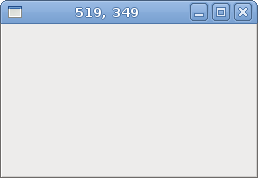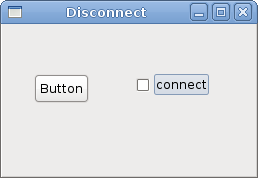Events in GTK#
In this part of the GTK# programming tutorial, we will talk about events.GTK# library is an event driven system. All GUI applications react to events. The applications start a main loop, which continuously checks for newly generated events. If there is no event, the application waits and does nothing. vents are generated mainly by the user of an application. But they can be generated by other means as well, e.g. internet connection, window manager or a timer.
Simple event example
The next example shows, how we react to two basic events.quitbutton.cs
using Gtk;In our code example, we react to two events. Delete event and Clicked event.
using System;
class SharpApp : Window {
public SharpApp() : base ("Button")
{
SetDefaultSize(250, 200);
SetPosition(WindowPosition.Center);
DeleteEvent += delegate { Application.Quit(); };
Fixed fix = new Fixed();
Button quit = new Button("Quit");
quit.Clicked += OnClick;
quit.SetSizeRequest(80, 35);
fix.Put(quit, 50, 50);
Add(fix);
ShowAll();
}
void OnClick(object sender, EventArgs args)
{
Application.Quit();
}
public static void Main()
{
Application.Init();
new SharpApp();
Application.Run();
}
}
The delete event is triggered, when we close the window. By default, the application does not quit, when we click on the close button in the titlebar.
DeleteEvent += delegate { Application.Quit(); };
When we use the delegate keyword, we can write in line code, that will react to this particular event. quit.Clicked += OnClick;Here we specify, that we react to
Clicked event, with the OnClick() method. void OnClick(object sender, EventArgs args)Here is the
{
Application.Quit();
}
OnClick() method. It takes two parameters. The first parameter is the object, which triggered this event. In our case it is the quit button. The second parameter gives us various additional information about the event. The event arguments depend always on the type of the event. The signature of each of the method can be found in the reference manual of the GTK# library. http://www.go-mono.com/docs/Moving window
The next example shows, how we react to move events of a window. We show the current position of the upper left corner of our window in the titlebar.move.cs
using Gtk;In the previous example, we have plugged a delegate or a method to an event. In GTK#, many of the events have a handler method already. In this case, we can override the method. This is the case, of our code example.
using System;
class SharpApp : Window {
public SharpApp() : base("")
{
SetDefaultSize(250, 150);
SetPosition(WindowPosition.Center);
DeleteEvent += delegate { Application.Quit(); };
Show();
}
protected override bool OnConfigureEvent(Gdk.EventConfigure args)
{
base.OnConfigureEvent(args);
Title = args.X + ", " + args.Y;
return true;
}
public static void Main()
{
Application.Init();
new SharpApp();
Application.Run();
}
}
protected override bool OnConfigureEvent(Gdk.EventConfigure args)Here we override the predefined
{
base.OnConfigureEvent(args);
Title = args.X + ", " + args.Y;
return true;
}
OnConfigureEvent() method. Configure event is triggered, when we resize or move a widget. Note, that the first line of the method calls the default method. Without this line, the program would not behave correctly. The next line sets the x, y coordinates of the window to the title of the window. 
Figure: Move event
EnterNotifyEvent
EnterNotifyEvent is emitted, when we enter the area of a widget with a mouse pointer. enter.cs
using Gtk;We will change the background color of the button widget, once we hover a mouse pointer over it.
using System;
class SharpApp : Window {
public SharpApp() : base("Enter")
{
SetDefaultSize(200, 150);
SetPosition(WindowPosition.Center);
DeleteEvent += delegate { Application.Quit(); };
Button button = new Button("Button");
button.EnterNotifyEvent += OnEnter;
Fixed fix = new Fixed();
fix.Put(button, 20, 20);
Add(fix);
ShowAll();
}
void OnEnter(object sender, EnterNotifyEventArgs args)
{
Button button = (Button) sender;
button.ModifyBg(StateType.Prelight, new Gdk.Color(220, 220, 220));
}
public static void Main()
{
Application.Init();
new SharpApp();
Application.Run();
}
}
button.EnterNotifyEvent += OnEnter;We plug the
OnEnter() method to to the EnterNotifyEvent. Button button = (Button) sender;We get the button widget and modify the color of it's background.
button.ModifyBg(StateType.Prelight, new Gdk.Color(220, 220, 220));
Disconnecting an event handler
We can disconnect a handler method from an event. Next code example demonstrates such a case.disconnect.cs
using Gtk;In the code example, we have a button and a check box. We show "Click" text in the console, when we click on the button and the check box is active. The check box connects or disconnects a handler method from the button
using System;
class SharpApp : Window {
Button button;
public SharpApp() : base("Disconnect")
{
SetDefaultSize(250, 150);
SetPosition(WindowPosition.Center);
DeleteEvent += delegate { Application.Quit(); };
button = new Button("Button");
CheckButton cb = new CheckButton("connect");
cb.Toggled += OnToggled;
Fixed fix = new Fixed();
fix.Put(button, 30, 50);
fix.Put(cb, 130, 50);
Add(fix);
ShowAll();
}
void OnClick(object sender, EventArgs args)
{
Console.WriteLine("Click");
}
void OnToggled(object sender, EventArgs args)
{
CheckButton cb = (CheckButton) sender;
if (cb.Active) {
button.Clicked += OnClick;
} else {
button.Clicked -= OnClick;
}
}
public static void Main()
{
Application.Init();
new SharpApp();
Application.Run();
}
}
Clicked event. CheckButton cb = new CheckButton("connect");
cb.Toggled += OnToggled;
We have a check box. This widget has a Toggled event. We plug a OnToggled() method to this event. CheckButton cb = (CheckButton) sender;These lines connect or disconnect an event handler, based on the state of the check box widget.
if (cb.Active) {
button.Clicked += OnClick;
} else {
button.Clicked -= OnClick;
}

Figure: Disconnect
This chapter was about events in GTK#.
No comments:
Post a Comment